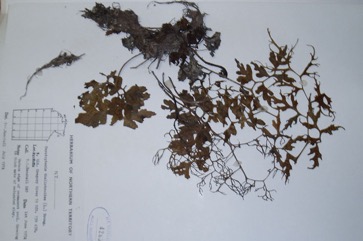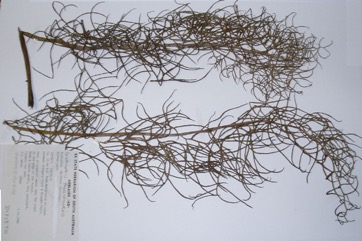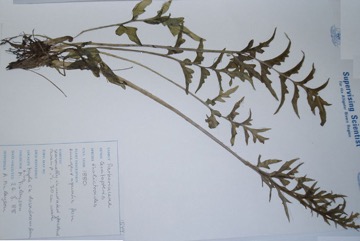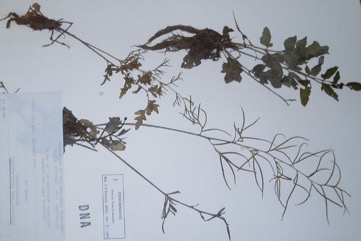Swamp fern, Water sprite, Water hornfern

A tropical plant. It grows in still or slow flowing fresh water in the tropics. It occurs in swamps up to 1300 m altitude in Papua New Guinea, but it is mostly below 500 m. It can float. It is found in all tropical countries. It is very frost tender. They occur throughout the Philippines near sea level on mud and are able to thrive in shallow water. It grows well in acidic soil (pH 5-6.5) and in shady places. It needs temperatures above 18°C. It grows in wetlands.
Also known as:
Floating stag's horn, Hihiawai, Oriental water fern, Pakis air, Pakis rawa, Pakis tespong, Paku chai, Paku roman, Paku tespong, Pani dhaniya, Pani dhekia, Pani shak, Sachi, Sayur kodok, Sumatra fern, Water fern
Synonyms
- Acrostichum thalictroides L
- Ceratoperis cornuta (P. Beauv.) Lepr.
- Ceratopteris siliquosa (L.) Copeland
- and others
Edible Portion
- Leaves, Fronds, Vegetable
Where does Swamp fern grow?
Found in: Africa, Angola, Asia, Australia, Bangladesh, Benin, Bolivia, Botswana, Burkina Faso, Burundi, Cambodia, Cameroon, Central Africa, Central African Republic, CAR, Central America, Chad, China, Congo, Congo DR, Côte d'Ivoire, East Africa, Eswatini, Ethiopia, Gabon, Ghana, Guam, Guianas, Guinea, Guinée, Guinea-Bissau, Guyana, Hawaii, Himalayas, India, Indochina, Indonesia, Ivory Coast, Japan, Kenya, Korea, Laos, Liberia, Madagascar, Malaysia, Malawi, Mali, Mozambique, Myanmar, Namibia, Nepal, Nigeria, Northeastern India, Pacific, Papua New Guinea, PNG, Philippines, SE Asia, Senegal, Sierra Leone, South Africa, Southern Africa, South America, Sri Lanka, Sudan, Suriname, Swaziland, Taiwan, Tanzania, Thailand, Togo, Uganda, Vietnam, West Africa, West Indies, Zambia, Zimbabwe
Notes: There are 3-4 Ceratopteris species. They are also put in the family Ceratopteridaceae and Parkeriaceae. It grows throughout the lowland tropic in estuaries and swamps.
Status: It is a commercially cultivated vegetable.
Growing Swamp fern, Water sprite, Water hornfern
Cultivation: It is grown as an aquarium plant. Small pieces of plant will root in mud. Spores can also grow.
Edible Uses: The plant is edible. It can be used raw or cooked. The young fronds are eaten in stir-fries. The young uncurled fronds can be eaten raw.
Nutrition Info
per 100g edible portion| Edible Part | Energy (kcal) | Protein (g) | Iron (mg) | Vitamin A (ug) | Vitamin c (mg) | Zinc (mg) | % Water |
|---|---|---|---|---|---|---|---|
| Leaves | 252 dw | 21.2 dw | - | - | - | - | 92.6 |
Swamp fern, Water sprite, Water hornfern Photos




References
Ambasta S.P. (Ed.), 2000, The Useful Plants of India. CSIR India. p 117 (As Ceratopteris siliquosa)
Amoroso, V. B., et al., 2017, Bringing back the Lost Value of Philippine EdibleFerns: Their Antioxidant, Proteins and Utilization. International Journal of Advanced research. 5(4), 757-770
Andrews, S.B., 1990, Ferns of Queensland. A handbook to the ferns and fern allies. Queensland DPI p 90
BARC, 2016, State of Biodiversity for Food and Agriculture in Bangladesh. Bangladesh Agricultural Research Council.
Bodkin, F., 1991, Encyclopedia Botanica. Cornstalk publishing, p 239
Bandyopadhyay, S., et al, 2012, A Census of Wild Edible Plants from Howrah District, West Bengal, India. Proceedings of UGC sponsored National Seminar 2012
Bull. Sci. Soc. Philom. Paris ser. 3, 8:186. 1822 ("1821")
Burkill, H. M., 1985, The useful plants of west tropical Africa, Vol. 5. Kew.
Burkill, I.H., 1966, A Dictionary of the Economic Products of the Malay Peninsula. Ministry of Agriculture and Cooperatives, Kuala Lumpur, Malaysia. Vol 1 (A-H) p 519
Chaffey, C.H., 1999, Australian Ferns. Growing them successfully. Kangaroo Press. p 11, 117
Cribb, A.B. & J.W., 1976, Wild Food in Australia, Fontana. p 134
Dangol, D. R. et al, 2017, Wild Edible Plants in Nepal. Proceedings of 2nd National Workshop on CUAOGR, 2017.
Elliot, W.R., & Jones, D.L., 1984, Encyclopedia of Australian Plants suitable for cultivation. Vol 3. Lothian. p 11
French, B.R., 1986, Food Plants of Papua New Guinea, A Compendium. Asia Pacific Science Foundation p 329
Gallagher, D. E., 2010, Farming beyond the escarpment: Society, Environment, and Mobility in Precolonial Southeastern Burkina Faso. PhD University of Michigan.
Ghosh, C. & Das A. P., 2011, Some useful and poisonous tea garden weeds from the Darjiling District of West Bengal, India. Pleione 5(1): 91 - 114
Goudey, C.J., 1988, A Handbook of Ferns for Australia and New Zealand. Lothian. p 74
Grubben, G. J. H. and Denton, O. A. (eds), 2004, Plant Resources of Tropical Africa 2. Vegetables. PROTA, Wageningen, Netherlands. p 173
Hu, Shiu-ying, 2005, Food Plants of China. The Chinese University Press. p 272
Hussey, B.M.J., Keighery, G.J., Cousens, R.D., Dodd, J., Lloyd, S.G., 1997, Western Weeds. A guide to the weeds of Western Australia. Plant Protection Society of Western Australia, p 12
Islam, M., 1983, Utilisation of Certain Ferns and Fern Allies in the North-Eastern Region, India. J. Econ. Tax. Bot. Vol.4. No.3 pp 861-
Jacquat, C., 1990, Plants from the Markets of Thailand. D.K. Book House p 32
Johns, R.J. & Bellamy, A., 1979, The Ferns and Fern Allies of Papua New Guinea. Forestry College, Bulolo Papua New Guinea. p 11.1
Kays, S. J., and Dias, J. C. S., 1995, Common Names of Commercially Cultivated Vegetables of the World in 15 languages. Economic Botany, Vol. 49, No. 2, pp. 115-152
Kenneally, K.E., Edinger, D. C., and Willing T., 1996, Broome and Beyond, Plants and People of the Dampier Peninsula, Kimberley, Western Australia. Department of Conservation and Land Management. p 49
Leach, G.J., Osborne, P.L., 1985, Freshwater Plants of Papua New Guinea. UPNG Press, p 54
Liu, Y., et al, 2012, Food uses of ferns in China: a review. Acta Societatis Botanicorum Poloniae 84(4): 263-270 (
Long, C., 2005, Swaziland's Flora - siSwati names and Uses http://www.sntc.org.sz/flora/
Luo, B., et al, 2019, Wild edible plants collected by Hani from terraced rice paddy agroecosystem in Honghe Prefecture, Yunnan, China. Journal of Ethnobiology and Ethnomedicine 15:56
Macmillan, H.F. (Revised Barlow, H.S., et al), 1991, Tropical Planting and Gardening. Sixth edition. Malayan Nature Society. Kuala Lumpur. p 356
Maroyi, A., 2014, Not just minor wild edible forest products: consumption of pteridophytes in sub-Saharan Africa. Journal of Ethnobiology and Ethnomedicine. 10:78
Monsalud, M.R., Tongacan, A.L., Lopez, F.R., & Lagrimas, M.Q., 1966, Edible Wild Plants in Philippine Forests. Philippine Journal of Science. p 513 (As Ceratopteris siliquosa)
Ng, X. N., et al, 2012, Nutritional profile and antioxidative properties of selected tropical vegetables. International Food Research Journal 19(4): 1487-1496
Ogle, B. M., et al, 2003, Food, Feed or Medicine: The Multiple Functions of Edible Wild Plants in Vietnam. Economic Botany 57(1): 103-117
Ojha, R. & Devkota, H. P., 2021, Edible and Medicinal Pteridophytes of Nepal: A Review. Ethnobotany Research & Applications 22:16
Omawale, 1973, Guyana's edible plants. Guyana University, Georgetown p 111
Paczkowska, G . & Chapman, A.R., 2000, The Western Australian Flora. A Descriptive Catalogue. Western Australian Herbarium. p 21
Patiri, B. & Borah, A., 2007, Wild Edible Plants of Assam. Geethaki Publishers. p 162
Pham-Hoang Ho, 1999, An Illustrated Flora of Vietnam. Nha Xuat Ban Tre. p 49 (As Ceratopteris siliquosa)
Peekel, P.G., 1984, (Translation E.E.Henty), Flora of the Bismarck Archipelago for Naturalists, Division of Botany, Lae, PNG. p 27, 26
Romanowski, N., 2007, Edible Water Gardens. Hyland House. p 40
Sainty, G.R. & Jacobs, S.W.L., 1981, Waterplants of New South Wales. Water Resources Commission. NSW p 339
Sarker, S. K., & Enayet Hossain, A. B. M., 2009, Pteridophytes of Greater Mymensingh District of Bangladesh used as Vegetables and Medicines. Bangladesh J. Plant Taxon. 16(1) 47-56. p 51
Singh, K.K., & Maheshwari, J.K., 1984, Studies of the Flora of Dudwa National Park. Kheri District, U.P. (Part 1) J. Econ. Tax. Bot. Vol 5 No. 2 pp 379-
Slocum, P.D. & Robinson, P., 1999, Water Gardening. Water Lilies and Lotuses. Timber Press. p 64
Staples, G.W. and Herbst, D.R., 2005, A tropical Garden Flora. Bishop Museum Press, Honolulu, Hawaii. p 42
Stephens, K.M., & Dowling, R.M., 2002, Wetland Plants of Queensland. A field guide. CSIRO p 62
Stone, B. C., 1970, The Flora of Guam. A Manual for the Identification of the Vascular Plants of the Island. Micronesica. Journal of the University of Guam. p 51 (As Ceratopteris gaudichaudii)
Sukarya, D. G., (Ed.) 2013, 3,500 Plant Species of the Botanic Gardens of Indonesia. LIPI p 858, 1148
Swaziland's Flora Database http://www.sntc.org.sz/flora
Wheeler, J.R.(ed.), 1992, Flora of the Kimberley Region. CALM, Western Australian Herbarium, p 34
Wild edible plants of Himachal Pradesh
World Checklist of Useful Plant Species 2020. Royal Botanic Gardens, Kew
www.eFloras.org Flora of China
Zhang, Y., et al, 2014, Diversity of wetland plants used traditionally in China: a literature review. Journal of Ethnobiology and Ethnomedicine. 10:72